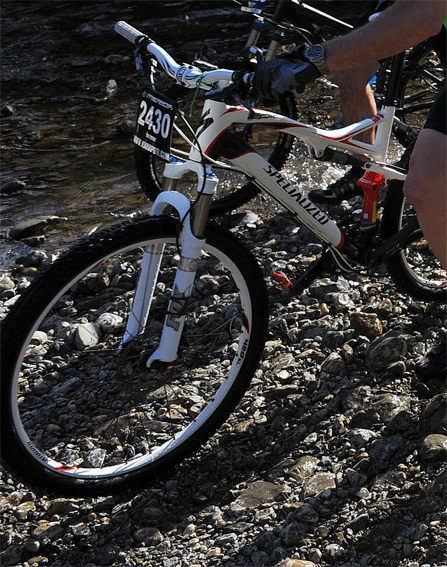Postponed for the first time in 27 years after a weather bomb on 3 March, “Karapoti Take2” two weeks later was a stunner! Perfect, still, clear and half the size of the normally crowded event. Lush New Zealand forest, gut busting climbs and rapid descents through the Akatarawas, pleased to be here instead of the regional road event passing by the startline on the same day.
Mountain racing is unforgiving – there is no way to hide ‘lack of form’. No drafting. No weakness goes undiscovered in relentless climbs that keep you in the red zone until you see spots dancing like moths in your vision. Ten months on from surgery (stitching an achilles back together), I have a secret weapon to build confidence – a new bike.
The start bursts through a thigh deep running river and on to a sealed section for a short drag race to the start of the gorge track. Sitting in with the front runners is as easy as… road cycling. Spinning up the gorge drops riders who can’t hold intensity, at this point a riding buddy and I are feeling pretty happy about the clear track ahead and the choice of the easier ‘weekend warriors group’.
An hour in, two climbs done and my pace is pretty nice – within 2 minutes of the ‘gold standard’ 3 hour finishing mark that the experts aim for. This snippet of deficit I expect I can make up on the last, long climb. In the past I’ve been strong there.
The Epic was smooth and supple, its an experience I call “Epic Erasure” – all the doubts of 2011 erased by a bike that climbs and descends.
But it wasn’t to last. The middle section of the race pushed me back into the humble corner. Failing to get any food in the first hour (couldn’t get my hands off the bars into my pockets), with complaining legs, I faded across the top of Deadwood and compounded it with a slow passage down the technical rock garden descent. 12 minutes gone from 3 hour target time! A big hunk of time to lose. Mainly about skills really. Watched some beautiful lines as a group of seven riders caught up and dropped down the jagged route.
Grabbed gels during the slow descent (finally able to reach rear pockets) in time to feel refreshed for the bike-carry-run up Devil’s Staircase.
This is 4 or so kms of grovel – pitching up to 30% in places. Its clay-ish. You’re climbing in cleats. Small steps 10 cm wide are just visible in the nearly vertical trail. A decent time means attempting to run with your bike up this.
Achilles recovey is slowest for hill running – its the last part of strenth to return, relying on a strong hamstring and some real power to ‘pop’ you up the step. Even strength, left to right sides, is also needed. I was nervous about this, building a lot of running into my build up (too much in fact).
It went well! Only a small margin on 3 hour finish time lost here (seconds) and no discernable additional agony over and above the zone 5 heart rate and general exhaustion.
Picked up the group of seven on the climb and powered on (3kms/hr) to the top.
The race may only be 50 kms, but it feels like you left civilization back in time. The 4 wheel drive tracks are really narrow slashes cut into forest like a claw across fleeing prey. There is mud. At one point a narrow supple branch caught in the vents in my helmet. I expected it to flick out. It just hung in there, until its spring force popped me backwards off the bike. Jurassic park moment.
The big descent to the last climb opens out into fast and loose gravel trails. Lost my second big hunk of time here.
The final climb is a solid 600 vertical metres in a few kms. Much longer than you expect, it pitches up to the top…. then does it again, each time you think you are there. Each time the pitch is steeper again. Rode through the ‘prams’ – pushing their bikes, pulled back some minutes and set myself up for a TT style effort back down the gorge to the finish.
Final time in the 3:20s – not awesome but not bad. Less running more riding required. I feel like I’ve completed a uniquely kiwi rite of passage. And removed all lagging doubts about the ankle.









You must be logged in to post a comment.